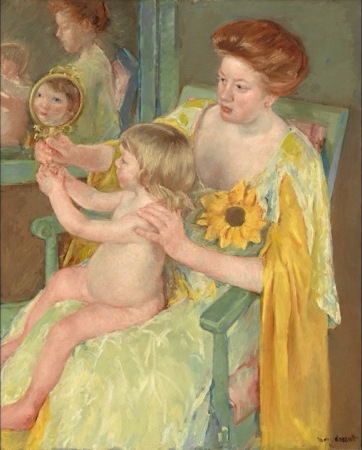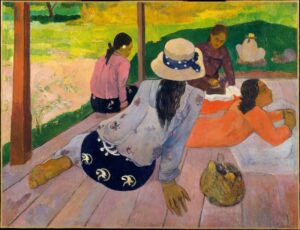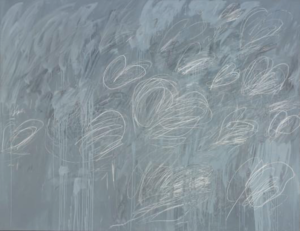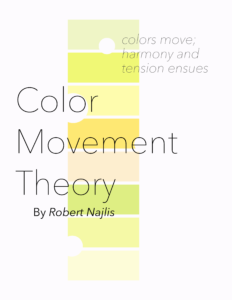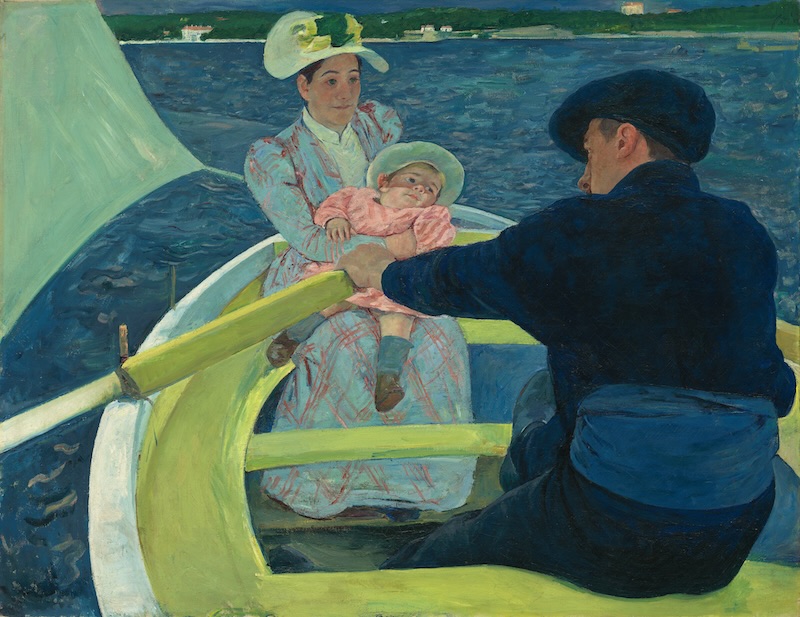
In the painting, The Boating Party, Mary Cassatt creates a wonderful painting full of harmony and tension, and she uses the positions of the figures and the locations and the attitudes and their relationships to help move us through the painting. For example, the sail, the way it’s angled and the way that it acts almost like an arrow pointing right towards a woman and a child. But it’s not just the shape of the object, it’s also the color. We can look at these colors and see how they’re affecting the feeling and the space and the work.
We talked about this in a previous video. We discussed how, despite the fact that child, and even to a certain extent the mother, but certainly the child is right in the middle of the painting, which is usually a really big no-no. Usually we’re told, don’t put the main subject right in the center of the painting, or really trying to put anything important in the center of the painting. But as it turns out, we can do this, as long as we’re able to keep movement through the work. And we saw how, partially through the alignment of the postures and the relationships of the figures, Mary Cassatt was able to create movement, despite the fact that the child was right in the center of the painting. But this isn’t the only thing that stands out about the painting, and it’s not the only thing that helps create movement in the work.
The way that Cassatt uses color is also wonderful. And she uses color to also add to that sense of harmony and tension within the work. Areas that really join together nicely, a great, nice, harmonious space, with colors that stand out, cause a bit of tension, cause a note of differentiation, cause us to shift in our feeling of how we’re relating to the work. And in the work, she tends to use areas of large, somewhat simple colors, not completely flat, but somewhat flat. We can see how the work of artists like Hiroshige has influenced Cassatt, and in fact influenced a lot of her contemporaries like Monet, Van Gogh, Whistler, and other artists at the time.
Let’s start by looking at some of these colors that I was just mentioning. The color of the woman’s dress, the sail, the water, and even the shoreline behind her. And let’s see how they create a very interesting, very important relationship for this painting.


All of these colors connect in one large area of the painting. If we look at these four colors, we can see how nicely they sit together, very harmoniously joining together. If, however, we throw in the yellow-green of the boat into the mix, we suddenly get a very different feeling. That yellow -green pops out, creating tension and disquietude. Now, going back to the painting, if we were to change the sail to that same yellow-green color, we now have much more tension in the work, and also, interestingly enough, less space. So, we see that color can affect not only the feeling, harmony, and tension, as we’ve been talking about, but also pictorial space.
The original color of the sail gives us more space by the fact that the color is so harmonious with the colors around it. If we look at the color of the woman’s dress, and the color of the sail, and the color of the water, there’s a way in which they work together, they join together, and it allows the woman to grow larger. It allows her to emerge and be larger.
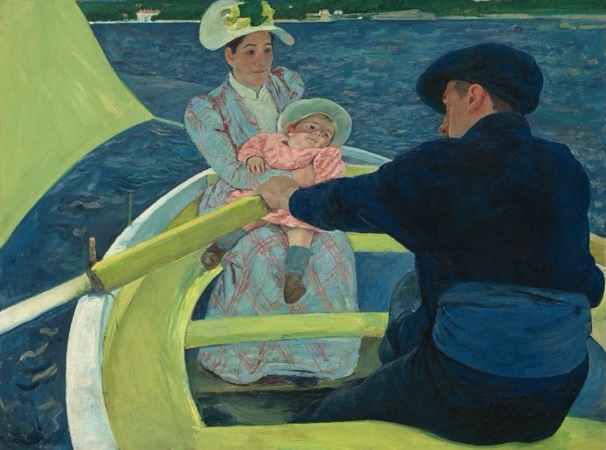
If we change the color, we can suddenly make her smaller, and we can change the feeling of the shape in a really strong way. These color choices are questions of harmony and tension, pushing and pulling, that affect the feeling of the space in the painting. Which one is right depends on what you want to say in your own work. Mary Cassatt, in this piece, chose colors which gave rise to an expansiveness and a large overall sense of movement. There’s a balance of harmony and tension in the work which creates movement in the whole piece. These questions of harmony and tension are fundamental to all of the arts, whether it be music, dance, literature, or indeed, color and the visual arts. My book, Color Movement Theory, goes deeply into questions of color, movement, harmony, and tension.
We can also see another example of Mary Cassatt and her brilliant use of color. This painting is called Woman with a Sunflower. Now, it could easily be called Woman with a Child, except that that sunflower really stands out.

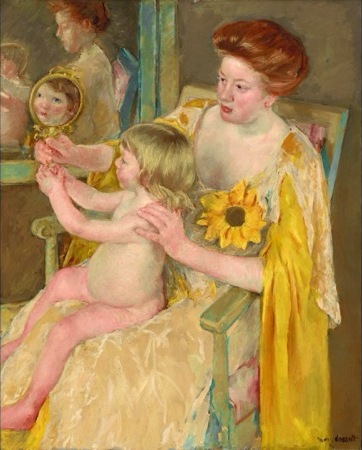
However, we’ll notice that there are a couple of ways that we could make that sunflower not stand out nearly as much, despite the fact that it’s quite large and quite prominent. But by changing either the color of the sunflower, or by leaving the color of the sunflower the same, but changing her dress and some of the colors around her, in these different ways, we could make the sunflower blend in a lot more, and then make it more about the woman and the child.
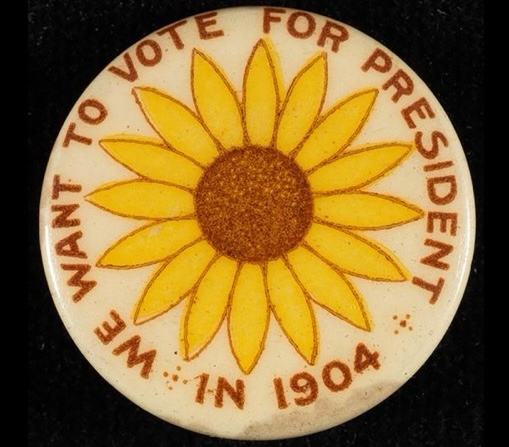
However, Mary Cassatt called this painting Woman with a Sunflower. And there’s a reason for that. At that time, the sunflower was representing the woman’s right to vote. And so this was actually a political statement. And I didn’t actually know this at first when I was looking at the painting. It wasn’t until I started researching the painting to teach about it that I realized, that’s why she wants this sunflower to stand out. But I suspect that if we were looking at this painting at that time, we probably would have been quite aware of it because that was something I’m sure very active in the social scene at the time. I’m sure we’d have known that sunflowers and the woman’s right to vote, that that was that relationship. So by making this sunflower so prominent at this time, and by titling it in this way, she’s made it very clear what she’s saying. But it’s very interesting how she was using color to help bring this point across, to help make that sunflower stand out so brilliantly. If we look at her clothing, she’s got draped around her this kind of reddish yellow. And the sunflower is this big reddish yellow. But all her dress is more this greenish yellow color. And the sunflower really stands out in that way. It stands out, and yet she builds a relationship where it fits in. It’s not something strange that doesn’t make sense there. It makes perfect sense. It makes perfect sense that the women have the right to vote. It makes perfect sense that that sunflower is there in that space, but it’s also standing out brilliantly and calling our attention to it.
I really enjoyed looking at Mary Cassatt’s colors. She is an amazing artist, and we will continue to look at her more in the future. Thank you for reading this post, I hope you found it enjoyable, useful and interesting.
Artwork:
Link to Mary Cassatt, The Boating Party at the National Gallery of Art https://www.nga.gov/artworks/46569-boating-party
Mary Cassatt, Woman with a Sunflower
https://www.nga.gov/artworks/46573-woman-sunflower
